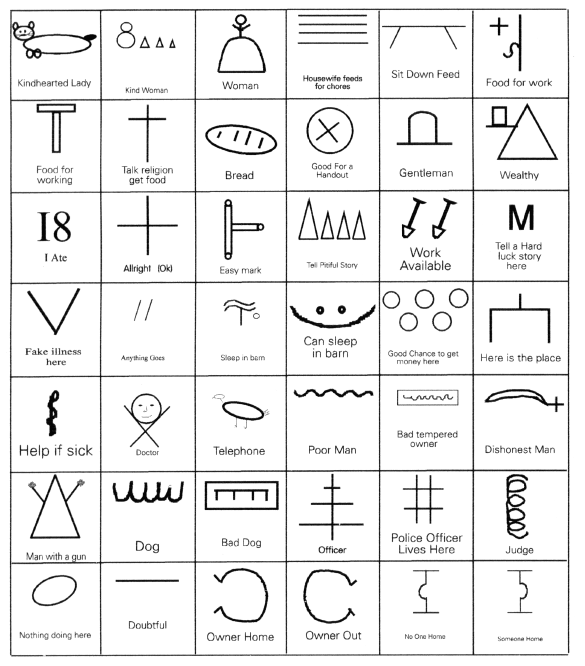Encyclopedia Dubuque
"Encyclopedia Dubuque is the online authority for all things Dubuque, written by the people who know the city best.”
Marshall Cohen—researcher and producer, CNN
Affiliated with the Local History Network of the State Historical Society of Iowa, and the Iowa Museum Association.
HOBOGLYPHS: Difference between revisions
(Created page with "HOBOGLYPHS. Hobos were nomadic workers at the start of the 20th century and through the GREAT DEPRESSION. Rejecting the often-called name "bum," they took work wherever th...") |
No edit summary |
||
| Line 5: | Line 5: | ||
The hobo culture was dependent on railroads. With fewer trains operating in the United States, the number of hobos has declined but in 2000 was still estimated at about 20,000. | The hobo culture was dependent on railroads. With fewer trains operating in the United States, the number of hobos has declined but in 2000 was still estimated at about 20,000. | ||
[[File:signs1.gif| | [[File:signs1.gif|300px|thumb|left|]] | ||
Revision as of 21:03, 30 December 2013
HOBOGLYPHS. Hobos were nomadic workers at the start of the 20th century and through the GREAT DEPRESSION. Rejecting the often-called name "bum," they took work wherever they could and never spent too long in one place. In their travels, hobos left notes for each other near railroads, on fences, buildings and trestles. These coded messages provided information on places to camp, find a meal, or dangers.
Because hobos were often illiterate, messages had to be easy to read but look little more than random markings to everyone else for secrecy. The code contained circles and arrows that made up the directional symbols. Hash marks or crossed lines usually meant danger. Many of the hoboglyphics were nearly impossible for people outside of the hobo community to understand. Other symbols were easier to understand: a cross meant anyone willing to talk positively about religion would get a free meal.
The hobo culture was dependent on railroads. With fewer trains operating in the United States, the number of hobos has declined but in 2000 was still estimated at about 20,000.
---
Hoboglyphs: Secret Transiest Symbols and Modern Nomad Codes, Web Urbanist, Online: http://weburbanist.com/2010/06/03/hoboglyphs-secret-transient-symbols-modern-nomad-codes/
Hobo Signs. Angelfire. Online: http://www.angelfire.com/folk/famoustramp/signs.html
CyberHobo's Signs. Online: http://www.cyberhobo.com/signs/hobosigns.html


